Papulonecrotic Tuberculid with Scrofuloderma: An Uncommon Association
Vinita Gupta1
1Assistant Professor, Department of Skin and VD,SGT Medical College and Research Institute, Budhera, Gurgaon, Haryana, India.
NAME, ADDRESS, E-MAIL ID OF THE CORRESPONDING AUTHOR: Dr. Vinita Gupta, H.No. 656, Sector 4, Urban Estate, Gurgaon – 122001, Haryana, India.
E-mail: Vinitagupta4@gmail.com
Cutaneous tuberculosis can be classified as true cutaneous tuberculosis and tuberculids which is regarded as a hypersensitivity reaction to M. tuberculosis in patients with a high degree of tuberculin sensitivity. Papulonecrotic tuberculid (PNT) is a form of tuberculid. It is an uncommon manifestation even in areas with high prevalence of tuberculosis.
We report a case of 35-year-old man who presented with necrotizing papules in symmetrical fashion over the trunk and extremities for last one year along with a discharging sinus in right axilla for last two months. Papulonecrotic tuberculid (PNT) with scrofuloderma were suspected on clinical examination. Mantoux test was strongly positive with 20x20mm. He was treated successfully with ATT without any further appearance of new lesions.
Cutaneous tuberculosis,Mantoux, M. tuberculosis,Necrotizing papules Varioliform scarring
Case Report
A 35-year-old male presented to our institution with one year history of asymptomatic, dark coloured elevated lesions over trunk and both extremities, with two month history of painless, discharging sinus in the right axilla. Lesions first started as asymptomatic, skin coloured to erythematous papules over both knees and elbows which subsequently developed necrosis and crusting in the centre and healed with pitted scarring. New crops of lesions continued to appear over a period of one year with predominant involvement of the extremities and few lesions scattered over trunk. Each crop of lesions healed rapidly with central crusting and atrophic scarring. Ten months after the onset of skin lesions, he developed a painless non tender, 2x2cm sized nodule over right axilla which ruptured within 15 d forming a sinus with serosanguinous discharge. There was no personal or family history of tuberculosis.
Examination revealed dusky red to brown coloured pea sized necrotizing papules along with atrophic varioliform scars present symmetrically over trunk and extremities, with predilection for knees and elbows [Table/Fig-1]. A 2x2 cm sized firm, non tender, subcutaneous indurated nodule was seen in the right axillary area, with central discharging sinus having bluish undermined edges [Table/Fig-2].
Systemic Examination was Normal
His laboratory investigations for complete blood count (CBC), liver and renal function tests were normal. ESR was 60mm/hr. Serology for VDRL and HIV was negative. Chest X-ray showed no evidence of active or healed tuberculosis. Ultrasound of abdomen and pelvis was normal. However, mantoux was strongly positive (20x20mm induration) [Table/Fig-3]. On the basis of clinical findings and strongly positive mantoux test, diagnosis of PNT with scrofuloderma was made and the patient was put on four drug regimen of ATT. New lesions stopped appearing within ten days and the old lesions showed significant healing, few with atrophic varioliform scarring [Table/Fig-4,Table/Fig-5].
Discussion
Papulonecrotic tuberculid is a chronic, recurrent and symmetrical eruption of necrotizing skin papules arising in crops, primarily involving the extensors of arms and legs. Other areas which may rarely be affected are buttocks, face, eyelids and glans penis. A focus of tuberculosis elsewhere in the body may not be demonstrable in majority of the cases with PNT, however cases have been reported where PNT was associated with lupus vulgaris [1,2].
The tuberculids, first described by Darrier in 1896 represent a form of cutaneous hypersensitivity reaction to tuberculosis antigen [3]. Although many types of tuberculids have been described, most are now understood to not be uniquely caused by tuberculosis. However, PNT and scrofuloderma are still widely accepted as true tuberculides.
The entity PNT was first established by Pautrier in 1936 as distinct tuberculosis associated disorder. PNT, the most common form of hyperergic response to mycobacteria or their fragments, is characterized by chronic, asymptomatic, symmetrical dusky red papules which heal with atrophic varioliform scarring. The sites of predilection are knees, elbows, legs, hands, feet but ears, face, buttocks and penis can be affected. Oral lesions have not been reported to date.
The basic diagnostic criteria for PNT are: a strongly positive mantoux test result, chronic recurrent papular eruptions occurring in crops, with necrosis, ulceration and scarring, a tuberculoid histology with endarteritis and thrombosis of dermal vessels and regression in response to ATT [4]. Females seem to be at a slightly increased risk for developing this disorder, so are the children and young adults. The condition typically follows a prolonged and relapsing course lasting years although spontaneous resolution has been reported. Progression to lupus vulgaris has been observed [1,2]. PNT has been reported to coexist with the lesions of erythema induratum [5,6] as well as lichen scrofulosorum [7].
Although, this entity is found to be associated with other tuberculides and lupus vulgaris, its association with scofuloderma is uncommon and only two cases of such an association has been reported to date [8,9]. We report this case of papulonecrotic tuberculid for its rare association with scrofuloderma.
Symmetrically distributed necrotizing papules on extensors of trunk and extremities
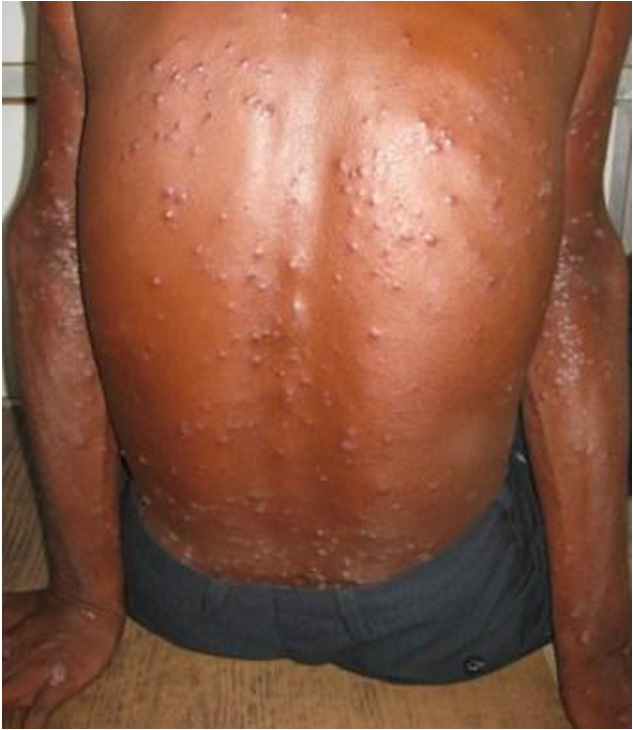
Indurate nodule with discharging sinus in the right axilla
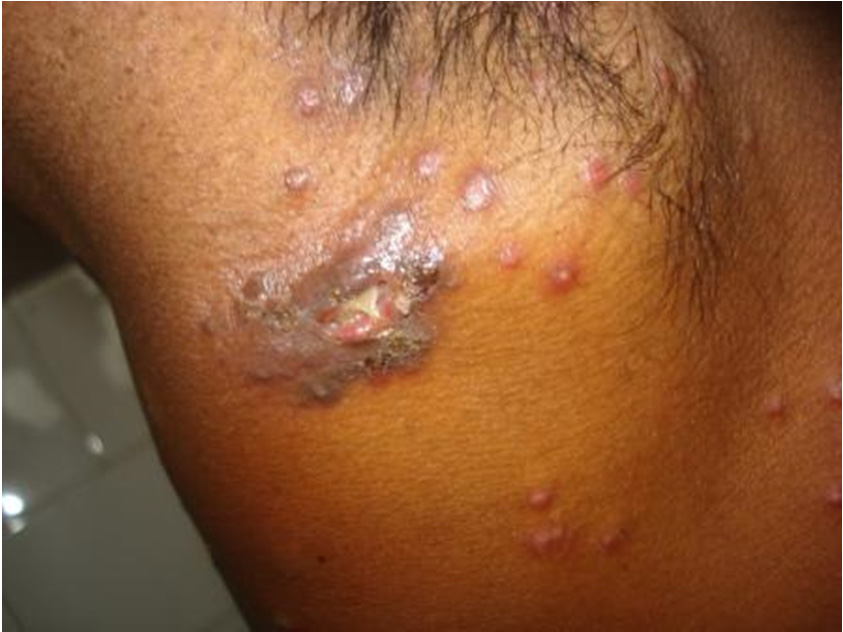
Strongly positive mantoux (20x20mm induration)
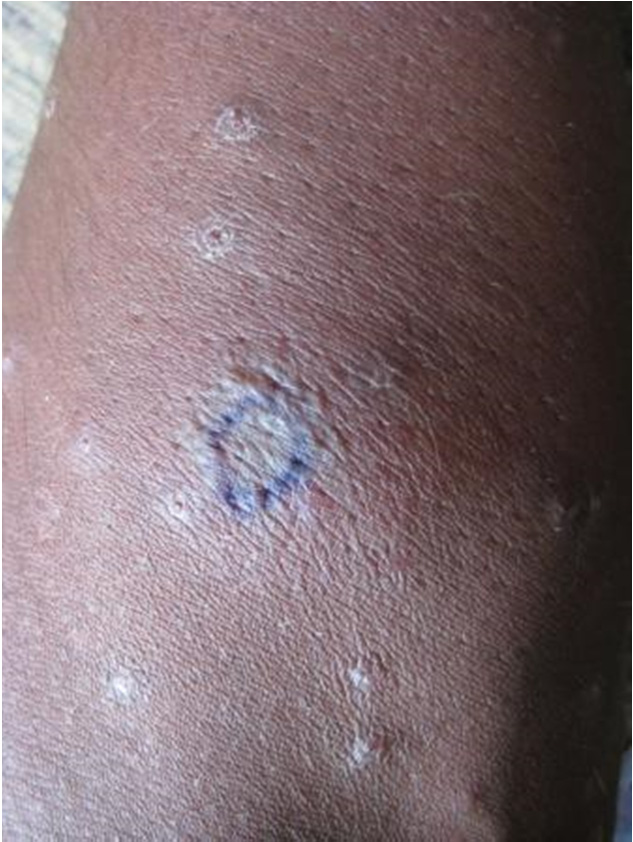
10 days after ATT: note the significant flattening and decrease in size of the lesions
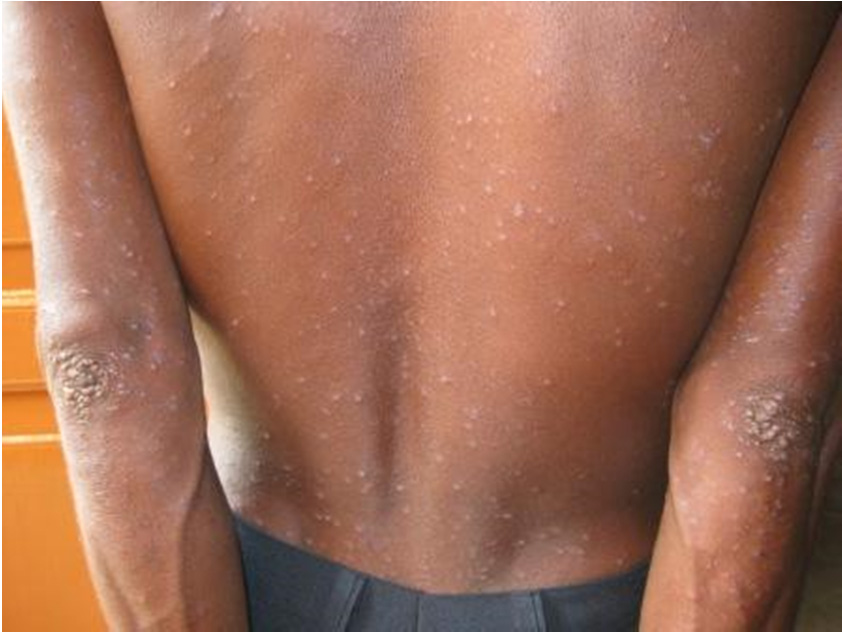
10 days after ATT: note the decrease in discharge, erythema and induration
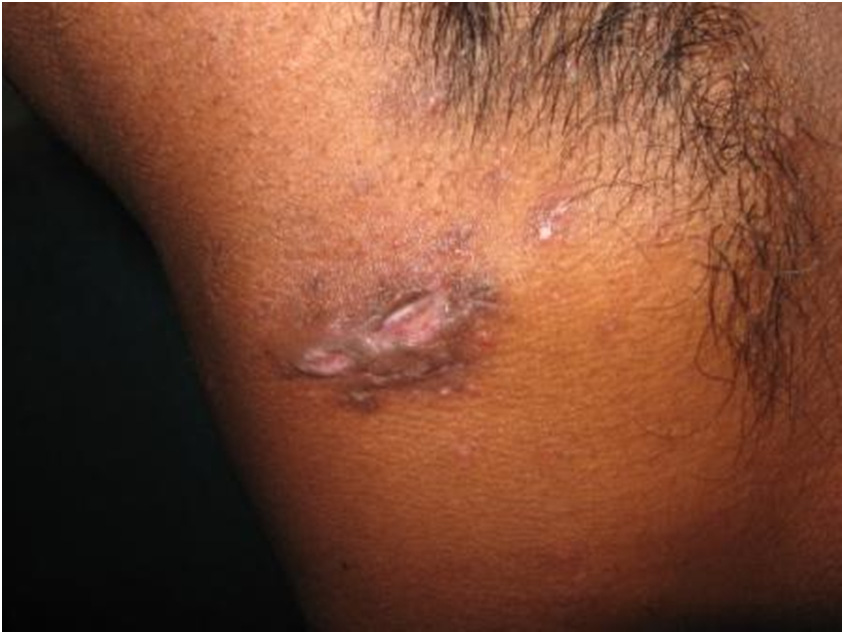
Conclusion
In India where tuberculosis is still prevalent and subclinical tuberculosis is common, the existence of PNT is possible and awareness about this disease is important. We report this case of papulonecrotic tuberculid for its rare association with scrofuloderma.
[1]. JG Morrison, ED Fourie, The papulonecrotic tuberculide. From Arthus reaction to lupus vulgaris Br J Dermatol 1974 91:263-70. [Google Scholar]
[2]. M Senol, A Ozcan, A Aydin, Y Karincaoglu, S Sasmaz, S Sener, Disseminated lupus vulgaris and papulonecrotic tuberculid: case report Pediatr Dermatol 2000 17:133-35. [Google Scholar]
[3]. MJ Darrier, Des. Tuberculides cutanees Ann Dermatol Syph 1896 7:1431-36. [Google Scholar]
[4]. W Jeyakumar, R Ganesh, MS Mohanram, A Shanmugasundararaj, Papulonecrotic tuberculids of the glans penis: case report Genitourin Med 1988 64:130-32. [Google Scholar]
[5]. A Milligan, K Chen, RA Graham-Brown, Two tuberculides in one patient: a case report of papulonecrotic tuberculide and erythema induratum occurring together Clin Exp Dermatol 1990 15:21-23. [Google Scholar]
[6]. YH Chuang, TT Kuo, CN Wang, WR Wong, HL Chan, Simultaneous occurrence of papulonecrotic tuberculid and erythema induratum and identification of mycobacterium tuberculosis DNA by polymerase chain reaction Br J Dermatol 1997 137:276-81. [Google Scholar]
[7]. DM Thappa, K Karthikeyan, S Jayanthi, Tuberculid in a child: transformation from papulonecrotic to lichen scrofulosorum Pediatr Dermatol 2003 20:91 [Google Scholar]
[8]. BM Almeida, SJ Challacombe, RJ Hay, PR Morgan, HJ Milburn, Papulonecrotic tuberculide complicating scrofuloderma in a health-care worker Br J Dermatol 1998 139:550-52. [Google Scholar]
[9]. Arora S, Arora G, Kakkar S, Cutaneous tuberculosis: a clinico-morphological study MJAFI 2006 62:344-47. [Google Scholar]